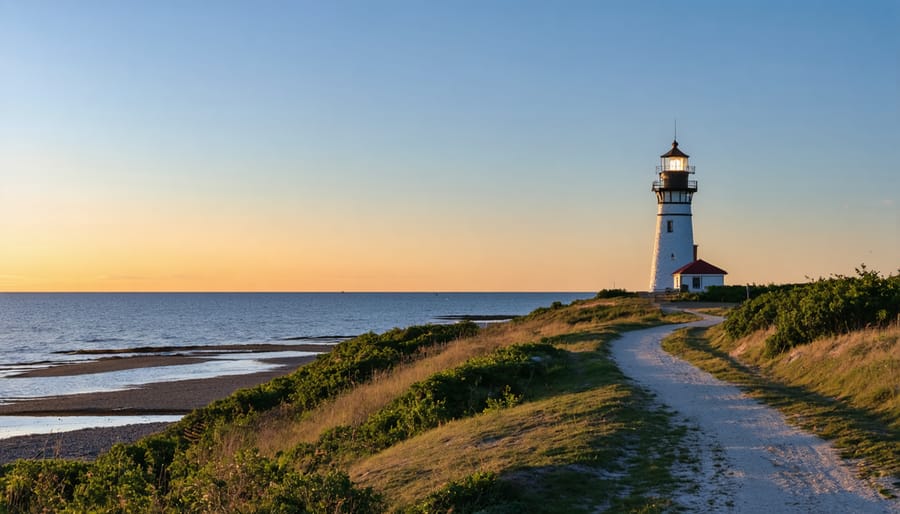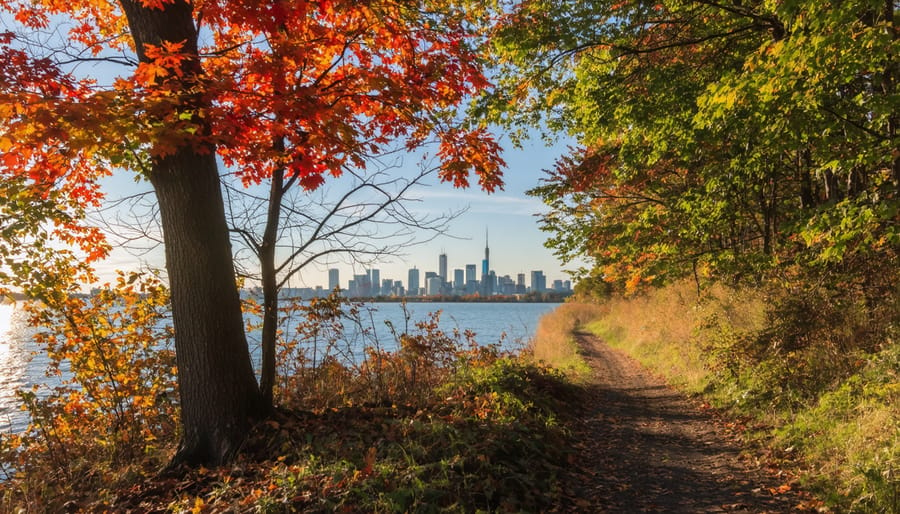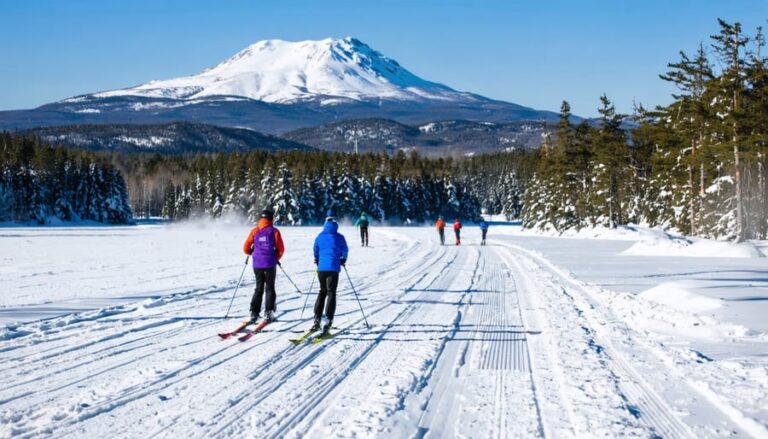Discover breathtaking lakeside vistas along Lake Ontario’s most spectacular Ontario’s best park trails, where rugged shorelines meet pristine wilderness. From the dramatic limestone cliffs of Presqu’ile Provincial Park to the serene waterfront paths of Burlington’s Waterfront Trail, these hiking destinations offer year-round adventures for both novice wanderers and seasoned trekkers.
Each trail tells a unique story of the Great Lakes’ natural heritage, winding through ancient forests, peaceful meadows, and historic lighthouse stations. Whether you’re seeking a challenging full-day expedition or a gentle morning stroll, Lake Ontario’s diverse network of trails provides the perfect backdrop for outdoor exploration in every season.
What sets these paths apart isn’t just their scenic beauty – it’s their accessibility and rich biodiversity. Spot rare migratory birds in spring, cool off by hidden beaches in summer, marvel at spectacular fall colors, or experience the quiet solitude of winter walks along the frozen shoreline. These trails aren’t just paths through nature; they’re gateways to some of Ontario’s most precious natural treasures.
Must-Try Shoreline Trails Along Lake Ontario
Presqu’ile Provincial Park Trails
Nestled on a peninsula jutting into Lake Ontario, Presqu’ile Provincial Park offers some of the most diverse and scenic hiking experiences along the lakeshore. The park’s 16 kilometers of trails wind through rare dune formations, coastal wetlands, and historic lighthouse grounds, making it a must-visit destination for nature enthusiasts.
The Marsh Boardwalk Trail is a highlight, stretching 1.2 kilometers through one of the largest protected marshlands in Ontario. The elevated wooden pathway provides intimate glimpses of turtles sunbathing on logs and herons stalking through the reeds. For the best wildlife viewing, try visiting during early morning hours when the marsh comes alive with bird activity.
Beach hunters will love the Owen Point Trail, which meanders along the shoreline and offers stunning views of Lake Ontario’s pristine beaches. This 2.5-kilometer trail features several viewing platforms perfect for bird watching, especially during spring and fall migrations. Don’t miss the historic 1840 lighthouse at the peninsula’s tip – it’s particularly photogenic during sunset.
The Jobes’ Woods Trail offers a shaded 1-kilometer loop through mature hardwood forest, complete with interpretive signs explaining the park’s unique ecology. For families with young children, the Pioneer Trail provides an easy 0.8-kilometer walk with plenty of benches for rest stops and opportunities to spot white-tailed deer.
Insider tip: Visit during mid-week in September to enjoy the trails with fewer crowds and witness the spectacular fall bird migration.

Sandbanks Provincial Park Pathways
Nestled along Lake Ontario’s eastern shore, Sandbanks Provincial Park offers a truly unique hiking experience through some of the world’s largest freshwater dune formations. The park’s extensive network of pathways winds through towering sand dunes, some reaching heights of 60 meters, creating an almost desert-like landscape that feels wonderfully out of place in Ontario.
The Dunes Trail, a must-visit 2.5-kilometer loop, takes you through rolling sand hills and offers breathtaking views of both West Lake and Lake Ontario. For the best experience, try hiking this trail during sunrise or sunset when the golden light creates stunning shadows across the dunes. Remember to stay on marked paths to protect the delicate dune ecosystem and its rare plants.
Beach lovers will appreciate the Woodlands Trail, which connects to the park’s famous sandy beaches. This 3.5-kilometer trail alternates between shaded forest sections and open dunes, making it perfect for hot summer days. Keep your eyes peeled for unique bird species that call these dunes home, especially during spring and fall migrations.
For a shorter walk, the Cedar Trail offers a gentle 1-kilometer route suitable for all skill levels. This trail includes several interpretive panels explaining the fascinating geological history of the dunes and how they were formed over thousands of years.
Pro tip: Visit during shoulder season (May or September) to avoid peak crowds and enjoy more peaceful hiking conditions. Don’t forget to bring water and sunscreen – the exposed dune environment can be quite intense during midday hours.
Rouge National Urban Park Trails
Rouge National Urban Park offers a unique blend of lakeside trails and urban wilderness, making it a standout destination for hikers in the Greater Toronto Area. Spanning over 79 square kilometers, this natural oasis connects Lake Ontario’s shoreline to the Oak Ridges Moraine through a network of well-maintained trails.
The Waterfront Trail section provides stunning views of Lake Ontario while leading hikers through marshlands and beach areas. As you venture inland, the Mast Trail offers a challenging ascent through a rare Carolinian forest, showcasing some of Ontario’s most diverse ecosystems. Keep an eye out for great blue herons and red-tailed hawks that frequently soar overhead.
For a gentler experience, the Monarch Trail loops through restored meadows and wetlands, perfect for family outings and nature photography. During spring and summer, these areas burst with wildflowers and attract countless butterflies, making it a favorite spot for wildlife enthusiasts.
A local tip: Visit during early morning hours to catch glimpses of deer grazing in the meadows and to avoid the afternoon crowds. The Cedar Trail offers excellent sunrise views over the lake, while providing shelter on warmer days thanks to its forest canopy.
Remember to bring sturdy shoes as some trails can get muddy after rain, and don’t forget your reusable water bottle – there are filling stations at major trailheads. The park’s trails are accessible year-round, though winter hiking requires appropriate gear and extra caution.
Seasonal Hiking Highlights
Spring and Summer Experiences
Spring awakens the Lake Ontario trails with an explosion of colorful wildflowers and vibrant wildlife activity. From April through May, trilliums carpet the forest floor, while trout lilies and spring beauties create a natural kaleidoscope along the shoreline paths. These trails offer some of the most rewarding outdoor activities in Ontario, especially for nature photographers and wildflower enthusiasts.
Bird watchers will find themselves in paradise during the spring migration season. Keep your binoculars ready to spot warblers, orioles, and various waterfowl species making their seasonal journey. The Peninsula Trail and Waterfront Trail sections are particularly popular spots for birding, offering clear views across the lake and through the canopy.
As summer arrives, the trails transform into cool refuges from the heat. Early morning hikes reward visitors with glimpses of deer grazing in meadows and foxes darting through the underbrush. Pack a picnic and take advantage of the numerous scenic lookout points where you can enjoy lunch with sweeping views of the sparkling lake waters.
For the best summer experience, bring plenty of water and sun protection, and consider hiking during the cooler morning or evening hours. Don’t forget your camera – the golden hour just after sunrise or before sunset offers spectacular photo opportunities of the lake and surrounding landscape.

Fall and Winter Adventures
Lake Ontario’s hiking trails transform dramatically as summer fades into fall, offering an entirely new perspective for outdoor enthusiasts. During autumn, the shoreline trails burst into a spectacular display of red maples, golden oaks, and amber birch trees, creating perfect photo opportunities and memorable hiking experiences.
The Waterfront Trail is particularly stunning in fall, with crisp leaves crunching underfoot and migrating birds adding splashes of movement to the colorful canopy. For the best fall colors, plan your hikes between late September and mid-October, when the foliage reaches its peak vibrancy.
Don’t pack away your hiking boots when winter arrives! The Lake Ontario region offers excellent winter hiking adventures with a different kind of beauty. Snow-covered trails provide peaceful solitude and crystal-clear views of the lake that summer hikers never experience. Many trails, like those in Presqu’ile Provincial Park, are maintained year-round and perfect for snowshoeing.
Pro tip: During winter hikes, pack microspikes or ice cleats for better traction, and don’t forget your thermos of hot chocolate! The lakeside paths can be windier and colder than inland trails, so dress in layers and bring wind protection. Early morning hikes offer the best chance to spot winter wildlife and catch stunning sunrise views over the frozen shoreline.
Trail Difficulty and Accessibility
Family-Friendly Options
Lake Ontario’s shoreline offers several gentle trails perfect for creating lasting family memories. The Waterfront Trail section near Cobourg Beach features a paved pathway ideal for strollers and young cyclists, with plenty of benches and picnic spots along the way. Little ones will love watching the boats and searching for beach glass along the shore.
The Lynde Shores Conservation Area in Whitby provides an enchanting experience for children, with easy walking trails and wildlife viewing opportunities. The forest boardwalk is especially exciting for kids, who can spot chipmunks, birds, and even deer if they’re lucky. Don’t forget to bring seeds – hand-feeding chickadees is a highlight for young visitors!
At Burlington’s Royal Botanical Gardens, the Hendrie Valley Trails offer smooth, well-maintained paths perfect for families. The shorter loops are manageable for tiny legs, and the interactive nature exhibits keep children engaged throughout the walk. The Cherry Hill Gate area is particularly family-friendly, featuring washroom facilities and a water fountain.
Pro tip: Visit these trails during early morning hours when temperatures are cooler and wildlife is most active. Pack plenty of snacks and water, and don’t forget to bring along a nature scavenger hunt list to keep the little ones excited and engaged throughout your adventure.

Challenging Routes
For seasoned hikers seeking a true adventure, Lake Ontario’s shoreline offers several challenging trail workouts that will test your endurance and reward you with breathtaking views. The Scarborough Bluffs Trail stands out with its steep climbs and technical sections, requiring careful navigation along the dramatic cliff edges. Pack plenty of water for this 6-kilometer route that includes multiple elevation changes.
The Niagara Escarpment section near Hamilton presents another demanding option, featuring rugged terrain and rocky outcrops. Experienced hikers will appreciate the Bruce Trail’s Webster’s Falls to Tew’s Falls loop, which combines challenging ascents with stunning waterfall views. This 4-kilometer stretch demands proper hiking boots and trekking poles, especially after rainfall.
For a full-day challenge, tackle the Rouge Valley Highland Creek Trail, where steep ravines and natural obstacles create an intense workout. The trail’s remote sections and varied terrain make it perfect for those looking to push their limits while enjoying pristine nature views. Remember to bring a trail map and inform someone of your hiking plans, as cell service can be spotty in these areas.
Local Tips and Essential Information
Parking and Access Points
Most Lake Ontario hiking trails offer convenient parking facilities and well-marked access points to enhance your outdoor experience. Major trailheads typically feature spacious parking lots with both paved and gravel surfaces. If you’re planning to visit popular spots like the Waterfront Trail or conservation areas, you’ll find dedicated day use park facilities with ample parking spaces.
Parking fees vary by location, with some areas offering free parking during off-peak seasons. Conservation areas generally charge between $5 to $15 for daily parking, while provincial parks require a vehicle permit. Pro tip: consider purchasing a seasonal pass if you plan to visit frequently – it’s both cost-effective and saves time at entry points.
Many trails feature multiple access points, making it easy to plan shorter segments or one-way hikes. Look for clearly marked trailhead signs, which often include useful information about trail conditions and difficulty levels. Some popular access points also offer amenities like washrooms, water fountains, and information kiosks.
For the best experience, arrive early during peak season (summer weekends and holidays) as parking lots can fill up quickly. Consider carpooling or using public transit where available – several trails are accessible via local bus routes, which helps reduce your environmental footprint while avoiding parking hassles.
Safety and Trail Etiquette
Before hitting the trails around Lake Ontario, let’s make sure you’re prepared for a safe and responsible hiking experience. Always check the weather forecast and trail conditions before setting out, and remember to pack plenty of water, especially during summer months. A basic first-aid kit, trail map, and fully charged phone are essential items for any hike.
When you’re on the trail, stay on marked paths to protect local flora and fauna. Many of these trails wind through sensitive ecological areas, so it’s crucial to practice “Leave No Trace” principles. Pack out what you pack in, and resist the urge to pick wildflowers or disturb wildlife.
If you’re hiking solo, let someone know your planned route and expected return time. For group hikes, keep your party together and maintain a comfortable pace that works for everyone. During peak seasons, you might encounter other trail users – remember to yield to uphill hikers and give horses and bikers plenty of space when passing.
Watch your step near the shoreline, as some areas can be slippery, especially after rain. During tick season (spring through fall), wear long pants and check yourself thoroughly after your hike. In winter, many trails remain accessible but require appropriate footwear with good traction.
Remember that cell service can be spotty in some areas, so don’t rely solely on your phone for navigation. Consider downloading offline maps before your journey, and carry a traditional compass as backup.
Lake Ontario’s hiking trails offer an unparalleled outdoor experience that captures the essence of Ontario’s natural beauty. From the rugged cliffs of the Scarborough Bluffs to the serene waterfront paths of Burlington, each trail tells its own story and provides a unique perspective of our magnificent Great Lake.
Whether you’re an experienced hiker seeking challenging terrain or a family looking for a peaceful weekend stroll, these trails cater to every skill level and interest. The diverse ecosystems you’ll encounter – from wetlands teeming with wildlife to ancient forests and sandy beaches – make every hiking adventure memorable and educational.
What sets Lake Ontario trails apart is their accessibility and the way they seamlessly blend urban convenience with natural wilderness. You can start your day hiking through pristine conservation areas and end it enjoying the amenities of nearby towns and cities. The trails are also fantastic year-round destinations, with each season bringing its own charm – from spring wildflowers to winter ice formations along the shore.
As stewards of these natural treasures, let’s remember to practice Leave No Trace principles and preserve these trails for future generations. Pack your water bottle, lace up your hiking boots, and set out to discover the hidden gems along Lake Ontario’s shoreline. Whether you’re seeking solitude, adventure, or simply a connection with nature, these trails are waiting to be explored.














+ There are no comments
Add yours